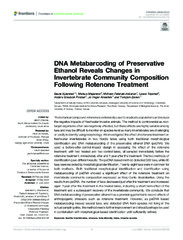DNA Metabarcoding of Preservative Ethanol Reveals Changes in Invertebrate Community Composition Following Rotenone Treatment
Permanent lenke
https://hdl.handle.net/10037/26756Dato
2022-06-01Type
Journal articleTidsskriftartikkel
Peer reviewed
Forfatter
Kjærstad, Gaute; Majaneva, Markus; Falahati-Anbaran, Mohsen; Topstad, Lasse; Finstad, Anders Gravbrøt; Arnekleiv, Jo Vegar; Ekrem, TorbjørnSammendrag
The botanical compound rotenone is extensively used to eradicate populations and reduce the negative impacts of freshwater invasive animals. The method is controversial as non-target organisms often are negatively affected, but these effects are highly variable among taxa and may be difficult to monitor on species-level as many invertebrates are challenging or costly to identify using morphology. We investigated the effect of rotenone treatment on freshwater invertebrates in two Nordic lakes using both traditional morphological identification and DNA metabarcoding of the preservative ethanol DNA (peDNA). We used a before-after-control-impact design in assessing the effect of the rotenone treatment, with two treated and two control lakes, all sampled immediately before the rotenone treatment, immediately after and 1 year after the treatment. The two methods of identification gave different results: The peDNA based method detected 333 taxa, while 90 taxa were recorded by morphological identification. Twenty-eight taxa were in common for both methods. Both traditional morphological identification and identification using metabarcoding of peDNA showed a significant effect of the rotenone treatment on invertebrate community composition expressed as Bray-Curtis dissimilarities. Using the results from peDNA, the number of taxa decreased just after the treatment and increased again 1 year after the treatment in the treated lakes, indicating a short-term effect of the treatment and a subsequent recovery of the invertebrate community. We conclude that DNA metabarcoding of preservative ethanol has a promising potential to record effects of anthropogenic stressors such as rotenone treatment. However, as peDNA based metabarcoding missed several taxa, and detected DNA from species not living in the actual sampling sites, the method needs further improvement and should perhaps be used in combination with morphological-based identification until sufficiently refined.
Forlag
Frontiers MediaSitering
Kjærstad G, Majaneva M, Falahati-Anbaran M, Topstad L, Finstad AG, Arnekleiv JV, Ekrem T. DNA Metabarcoding of Preservative Ethanol Reveals Changes in Invertebrate Community Composition Following Rotenone Treatment. Frontiers in Environmental Science. 2022;10Metadata
Vis full innførselSamlinger
Copyright 2022 The Author(s)


 English
English norsk
norsk